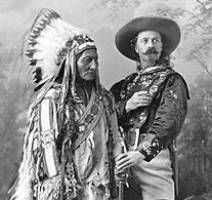
History courses are filled with people who have "made" history. In this lesson, students will analyze historical figures and make connections about their places in history. Students will research an early American historical figure of their choice and examine their impact during their historical period,... Read more »
Analyzing History
Subject
Course
Grade Level
Standards

Intro to the American Industrial Revolution
Grade Level
In this lesson, students will work on their very own assembly line to create "kicks'' fit for the Second Industrial Revolution. Through an exploration of texts and videos, students will begin to formalize their understanding of industrialization and how technological change and innovation has impacted... Read more »
Intro to the American Industrial Revolution
Grade Level
Subject
Course
Standards

Students will begin by discussing what clocks do and using prior knowledge to compare analog, digital, and written time in a matching game. They will then work as a class to learn how to tell time using the different clocks and create a visual guide of their routines. Differentiation and parent extension... Read more »
Telling Time
Grade Level
Subject
Standards

This lesson is intended to introduce the unit circle, leading into the concept of radians as a unit rather than degrees. This lesson is intended to introduce the concept at the beginning of the unit, but it could also work as remediation if students are just not getting it. Read more »
The Unit Circle / Trigonometry
Grade Level
Course
Subject
Standards

In this lesson, students investigate how to determine how much time has passed (by five-minute intervals). Prerequisites for this lesson are knowledge that time passes, that a clock measures time, and how to read a clock by five-minute intervals. Skip counting by fives is also needed for this lesson. Read more »
Elapsed Time
Grade Level
Subject
Standards

History courses are filled with people who have "made" history. In this lesson, students will analyze historical figures and make connections about their places in history. Students will research an American historical figure and examine that person's impact during the period in which they lived, as... Read more »
Analyzing History
Grade Level
Subject
Course
Standards

This lesson invites students to analyze literary figures and to make connections regarding how they fit into the context of the literary world. After participating in a Tell Me Everything activity to assess prior knowledge on the subject, students will research a literary figure of their choice and... Read more »
Analyzing Literature
Grade Level
Subject
Course
Standards

History courses are filled with people who have "made" history. In this lesson, students will analyze historical figures and make connections about their places in history. Students will research an Oklahoma historical figure of their choice and examine their impact during their historical period, as... Read more »
Analyzing History
Subject
Course
Grade Level
Standards

History courses are filled with people who have "made" history. In this lesson, students will analyze historical figures and make connections about their places in history. Students will research a world historical figure of their choice and examine their impact during their historical period, as well... Read more »
Analyzing History
Grade Level
Subject
Course
Standards

The main cause of the French Revolution is still debated by historians today. In this lesson, students will begin by activating prior knowledge as they complete a Tell Me Everything activity on revolutions. They will sort conditions in a society that can lead to revolution into categories of political,... Read more »
Exploring Causes of the French Revolution
Subject
Course
Grade Level
Standards

Sometimes, students have an aversion to writing because they lack a sense of purpose. In this lesson, students learn that letters can be an important way to communicate and can be fun to write. First, students brainstorm what they already know about letters and then explore letters written by a variety... Read more »
Writing Letters
Grade Level
Related
Standards

In this lesson, students will learn about China’s Civil War from 1945-1949. Participating in a discussion about why people rebel against their governments, they will analyze an excerpt from an article about the life of peasants in China prior to the conflict under the Kuomintang rule and an article... Read more »
China's Civil War
Subject
Course
Grade Level
Standards

Introduction to Latitude and Longitude
Grade Level
In this lesson, students are introduced to maps and globes as models of the Earth. They will begin this lesson by thinking and sharing with their classmates what they already know about globes and maps. Each student will explore a tiled map of the Hawaiian Islands (or another state or region) to find... Read more »
Introduction to Latitude and Longitude
Grade Level
Subject
Related
Standards

Understanding the contributions of sociological theorists can provide insight into the field of sociology. This lesson explores the contributions of eight key figures and enables students to dive deep into research to learn more. This lesson should be taught after students have a working knowledge of... Read more »
The Foundations of Sociology
Grade Level
Subject
Course
Standards

In this geometry lesson, students will recall vocabulary about a circle, use their knowledge of midpoint and distance formulas to write the equation of a circle, and explore the connection between the equation of a circle and the Pythagorean Theorem. This is a multimodality lesson, which means it includes... Read more »
Writing the Equation of a Circle
Course
Subject
Grade Level
Standards

Systems of Linear Equations: Substitution and Elimination
Grade Level
This lesson focuses on how to analyze and solve systems of linear equations by using the substitution and elimination methods. Students will use their prior knowledge of the components of a system to solve problems algebraically. Students will identify, solve, and write equations using substitution... Read more »
Systems of Linear Equations: Substitution and Elimination
Grade Level
Course
Subject
Standards

There is a special kind of magic in hearing the words you have written spoken out loud. Spoken word poetry is meant to be heard and performed rather than read silently from a page. In this lesson, students analyze the techniques spoken word poets use to engage an audience and examine the devices they... Read more »
Techniques in Spoken Word Poetry
Related
Grade Level
Subject
Course
Standards

Students will learn how tornadoes form, information about tornado safety, and how engineers use models to create weather safe structures. Students will design, build, and revise a structure that will withstand strong winds simulated by a fan. They will use this information to make connections to their... Read more »
Tornado Safety and Engineering/STEM
Grade Level
Subject
Standards

Ecological Energy Pyramids and Science Illustration
Grade Level
This lesson introduces the idea of energy flow in ecosystems using energy pyramids. It also exposes students to a career in scientific illustration. Students participate in a game that models energy flow through trophic levels and calculate the transfer of energy up an energy pyramid. After learning... Read more »
Ecological Energy Pyramids and Science Illustration
Related
Grade Level
Subject
Course
Standards

Swimming in your local lake, you feel what you think is seaweed. But is it? When there's something strange in your local habitat, who ya gonna call? Mulder & Scully! In this third lesson of the Monster Monday series, students examine informational texts for examples to model and craft their own informative... Read more »
Writing with Water Cryptids
Grade Level
Subject
Course
Related
Standards

Escher's Terrific Tessellations: The Art of Tile Transformations
Grade Level
In this follow-up lesson to "Diamonds, Not Just a Girl's Best Friend," students explore an app that creates Escher-like drawings. Students discuss the principles of design in the drawings. Students discuss Escher and then discuss similarities of the Plains tribes art that precede Escher. Students reflect... Read more »
Escher's Terrific Tessellations: The Art of Tile Transformations
Grade Level
Subject
Course
Standards

This lesson invites students to analyze historical figures in the field of psychology and to make connections regarding their impact in their field of study. Students will research a historical figure and examine that person's impact during the period in which they lived, as well as their long lasting... Read more »
Analyzing Historical Figures
Grade Level
Subject
Course
Standards

In this lesson, students leverage their prior knowledge of numerical long division, factoring, and graphing as a foundation for exploring polynomial division. The lesson formalizes student knowledge of polynomial long division, covering both scenarios with and without remainders. Through active practice... Read more »
Polynomial Division
Grade Level
Course
Subject
Standards
In this lesson, students learn the history, culture, and importance of Historically Black Colleges and Universities. Students begin by becoming familiar with some of the many famous and successful people who attended HBCUs. Then, after reading a short article about the history of HBCUs, they perform... Read more »
Target Audience
Calendar Placement
Group Size
Intention Or Purpose
ICAP (Individual Career Academic Planning)
College & Career Readiness Framework

In this lesson, students will learn about the rise of Asian American and Native American Pacific Islander-Serving Institutions (AANAPISi) and the important role they play in postsecondary education. Students will begin by becoming familiar with some of the many famous and successful people who attended... Read more »
Target Audience
Calendar Placement
Group Size
Intention Or Purpose
College & Career Readiness Framework
Family Engagement

In this lesson, students will learn about the history of Ivy League institutions and their role in postsecondary education. They will begin by becoming familiar with some of the many famous and successful people who attended Ivy League schools. Students will explore and conduct their own research on... Read more »
Target Audience
Calendar Placement
Group Size
Intention Or Purpose
College & Career Readiness Framework

This resource is geared towards students' goal setting and reflection process while participating in extracurricular clubs. Students set a goal for a specific skill they are working on and are given several ways to reflect on their progress towards that goal. Read more »
Calendar Placement
Group Size
Intention Or Purpose

In this GEAR UP Overview session, high school faculty and staff will be asked to identify the activities and experiences that students need to be prepared for a career and postsecondary education. They will also recognize how GEAR UP supports schools and their staff in creating these experiences. Read more »
Target Audience
Calendar Placement
Intention Or Purpose

